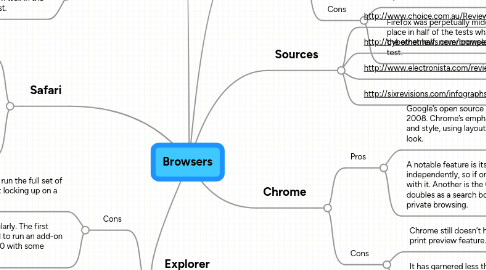
1. Opera
1.1. Pros
1.1.1. More of an internet suite than just a browser
1.1.2. Gives you tools to do a wide range of tasks besides browsing. This includes: email, managing contacts, chatting on Internet Relay Chat (IRC) clients, downloading files via BitTorrent, and reading Web feeds.
1.2. Cons
1.2.1. Did not score very will in Java Script Speed test.
1.2.2. Did not perform well in the CPU Usage test.
2. Explorer
2.1. Cons
2.1.1. Internet Explorer couldn’t run the full set of tests and in this case kept locking up on a "base64" sub-test.
2.1.2. Internet Explorer failed the test spectacularly. The first time IE ran Acid3, it stated that it needed to run an add-on called MSXML 3.0 and it made it to 12/100 with some random graphical errors.
2.2. Pros
2.2.1. Its massive market share means web developers have to take compatibility with IE into account when creating any website.
2.2.2. With the Microsoft behemoth behind it, Internet Explorer is probably the baseline for web browsing.
3. Safari
3.1. Pros
3.1.1. Apple’s own browser is available for Mac OS X and for Windows, powered by the speedy WebKit engine and with mobile versions for the iPhone and iPod Touch.
3.1.2. Safari incorporates the look and feel of Mac OS X with the Cover Flow feature that lets you flip through pages of your browsing history and bookmarks and also includes tabbed browsing, page previews and private browsing.
3.2. Cons
3.2.1. 1.5 percent variance or less and Safari generated the most scattered scores, at around 4 percent variance
3.2.2. Did not do to good in the Browser Cache Performance test.
4. Firefox
4.1. Pros
4.1.1. Firefox’s developer, Mozilla, claims more than 6000 free add-ons are available to choose from. Popular Firefox extensions include ad blockers, appearance enhancers, toolbars, video downloaders, social networking tools and security enhancers.
4.1.2. Offers a high level of customisability due to third-party support for its extensible architecture, which lets you install add-on programs to give the browser extra capabilities. This helps keep Firefox relatively lean, but allows individual users to add specific features that they like.
4.2. Cons
4.2.1. Mozilla claims Firefox 3.5 is more than twice as fast as Firefox 3, and 10 times as fast as Firefox 2, but our testing shows it still lags behind Chrome, Safari and Opera.
4.2.2. Firefox was perpetually middling and came in third place in half of the tests while reaching second place the other half, never completely winning any one test.
5. Chrome
5.1. Pros
5.1.1. Google’s open source browser, released in late 2008. Chrome’s emphasis is on speed, simplicity and style, using layout themes and an uncluttered look.
5.1.2. A notable feature is its stability – each tab works independently, so if one crashes, the others don’t go down with it. Another is the Omnibox – Chrome’s address bar that doubles as a search box. It also has an “incognito” mode for private browsing.
5.2. Cons
5.2.1. Chrome still doesn’t have a print preview feature.
5.2.2. It has garnered less than 5 percent of the global browser market.
